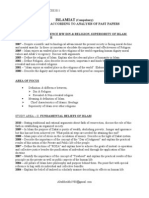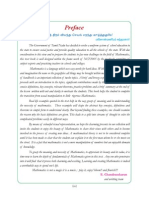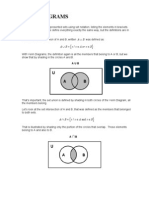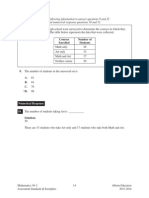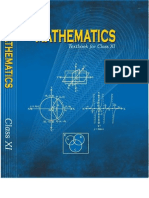Math Handout 8
Math Handout 8
Uploaded by
gcuusmanCopyright:
Available Formats
Math Handout 8
Math Handout 8
Uploaded by
gcuusmanCopyright
Available Formats
Share this document
Did you find this document useful?
Is this content inappropriate?
Copyright:
Available Formats
Math Handout 8
Math Handout 8
Uploaded by
gcuusmanCopyright:
Available Formats
Discrete Mathematics (MTH202)
LECTURE # 8
UNION:
Let A and B be subsets of a universal set U. The union of sets A and B is the set
of all elements in U that belong to A or to B or to both, and is denoted A B.
Symbolically:
A B = {x U | x A or x B}
EMAMPLE:
Let U = {a, b, c, d, e, f, g}
A = {a, c, e, g},
B = {d, e, f, g}
Then A B = {x U | x A or x B}
={a, c, d, e, f, g}
VENN DIAGRAM FOR UNION:
U
B
A B is shaded
REMARK:
1.
A B = B A that is union is commutative you can
prove this very easily only by using definition.
2.
A A B and
BAB
The above remark of subset is easily seen by the definition of union.
MEMBERSHIP TABLE FOR UNION:
A
1
1
0
0
B
1
0
1
0
AB
1
1
1
0
REMARK:
This membership table is similar to the truth table for logical
connective, disjunction ().
INTERSECTION:
Let A and B subsets of a universal set U. The intersection of sets
A and B is the set of all elements in U that belong to both A and B and is denoted
A B.
Symbolically:
A B = {x U | x A and x B}
EXMAPLE:
Let
U = {a, b, c, d, e, f, g}
Page 1 of 12
Copyright Virtual University of Pakistan
Discrete Mathematics (MTH202)
A = {a, c, e, g},
B = {d, e, f, g}
Then A B = {e, g}
U
B
A B is shaded
VENN DIAGRAM FOR INTERSECTION:
REMARK:
1. A B = B A
2. A B A and
ABB
3. If A B = , then A & B are called disjoint sets.
MEMBERSHIP TABLE FOR INTERSECTION:
A
1
1
0
0
B
1
0
1
0
AB
1
0
0
0
REMARK:
This membership table is similar to the truth table for logical
connective, conjunction ().
DIFFERENCE:
Let A and B be subsets of a universal set U. The difference of A and B (or
relative complement of B in A) is the set of all elements in U that belong to A but
not to B, and is denoted A B or A \ B.
Symbolically:
A B = {x U | x A and x B}
EXAMPLE:
Let
U = {a, b, c, d, e, f, g}
A = {a, c, e, g},
B = {d, e, f, g}
Then A B = {a, c}
VENN DIAGRAM FOR SET DIFFERENCE:
Page 2 of 12
Copyright Virtual University of Pakistan
Discrete Mathematics (MTH202)
U
A
A-B is shaded
REMARK:
1. A B B A that is Set difference is not commutative.
2. A B A
3. A B, A B and
B A are mutually disjoint sets.
MEMBERSHIP TABLE FOR SET DIFFERENCE:
A
1
1
0
0
B
1
0
1
0
AB
0
1
0
0
REMARK:
The membership table is similar to the truth table for ~ (p q).
COMPLEMENT:
Let A be a subset of universal set U. The complement of A is the set of all
element in U that do not belong to A, and is denoted A, A or Ac
Symbolically:
Ac = {x U | x A}
EXAMPLE:
Let
U = {a, b, c, d, e, f, g]
A = {a, c, e, g}
Then Ac = {b, d, f}
VENN DIAGRAM FOR COMPLEMENT:
U
Ac
A
Ac is shaded
REMARK :
1. Ac = U A
2. A Ac =
Page 3 of 12
Copyright Virtual University of Pakistan
Discrete Mathematics (MTH202)
3. A Ac = U
MEMBERSHIP TABLE FOR COMPLEMENT:
A
1
0
Ac
0
1
REMARK
This membership table is similar to the truth table for logical connective
negation (~)
EXERCISE:
Let
U = {1, 2, 3, , 10},
X = {1, 2, 3, 4, 5}
Y = {y | y = 2 x, x X},
Z = {z | z2 9 z + 14 = 0}
Enumerate:
(1)X Y
(2) Y Z
(3) X Z
(4)Yc
(5) Xc Zc
(6) (X Z) c
Firstly we enumerate the given sets.
Given
U = {1, 2, 3, , 10},
X = {1, 2, 3, 4, 5}
Y = {y | y = 2 x, x X} = {2, 4, 6, 8, 10}
Z = {z | z2 9 z + 14 = 0} = {2, 7}
(1)
X Y = {1, 2, 3, 4, 5} {2, 4, 6, 8, 10}
= {2, 4}
(2)
Y Z = {2, 4, 6, 8, 10} {2, 7}
= {2, 4, 6, 7, 8, 10}
(3)
X Z = {1, 2, 3, 4, 5} {2, 7}
= {1, 3, 4, 5}
c
(4)
Y = U Y = {1, 2, 3, , 10} {2, 4, 6, 8, 10}
= {1, 3, 5, 7, 9
c
c
(5)
X Z = {6, 7, 8, 9, 10} {1, 3, 4, 5, 6, 8, 9, 10}
= {7}
(6)
(X Z)c = U (X Z)
= {1, 2, 3, , 10} {1, 3, 4, 5}
= {2, 6, 7, 8, 9, 10}
NOTE
(X Z)c Xc - Zc
EXERCISE:
Given the following universal set U and its two subsets P and Q, where
U = {x | x Z,0 x 10}
P = {x | x is a prime number}
Q = {x | x2 < 70}
(i) Draw a Venn diagram for the above
(ii) List the elements in Pc Q
SOLUTION:
Page 4 of 12
Copyright Virtual University of Pakistan
Discrete Mathematics (MTH202)
First we write the sets in Tabular form.
U = {x | x Z, 0 x 10}
Since it is the set of integers that are greater then or equal 0 and less or equal to
10. So we have
U= {0, 1, 2, 3, , 10}
P = {x | x is a prime number}
It is the set of prime numbers between 0 and 10. Remember Prime numbers are
those numbers which have only two distinct divisors.
P = {2, 3, 5, 7}
Q = {x | x2 < 70}
The set Q contains the elements between 0 and 10 which has their square less or
equal to 70.
Q= {0, 1, 2, 3, 4, 5, 6, 7, 8}
Thus we write the sets in Tabular form.
VENN DIAGRAM:
U
Q
2,3,5,7P
0,1,4,6,8
9,10
c
(i)
P Q=?
Pc = U P = {0, 1, 2, 3, , 10}- {2, 3, 5, 7}
= {0, 1, 4, 6, 8, 9, 10}
and
Pc Q = {0, 1, 4, 6, 8, 9, 10} {0, 1, 2, 3, 4, 5, 6, 7, 8}
= {0, 1, 4, 6, 8}
EXERCISE:
Let
U = {1, 2, 3, 4, 5},
C = {1, 3}
and A and B are non empty sets. Find A in each of the following:
(i) A B = U,
AB=
and
B = {1}
(ii) A B and
A B = {4, 5}
(iii) A B = {3},
A B = {2, 3, 4}
and
B C = {1,2,3}
(iv) A and B are disjoint, B and C are disjoint, and the union of A and B
is the set {1, 2}.
(i) A B = U, A B =
and B = {1}
SOLUTION
Since A B = U = {1, 2, 3, 4, 5}
and A B = ,
Therefore
A = Bc = {1}c = {2, 3, 4, 5}
Page 5 of 12
Copyright Virtual University of Pakistan
Discrete Mathematics (MTH202)
(i)
A B and
A B = {4, 5}
also
C = {1, 3}
SOLUTION
When A B, then
A B = B = {4, 5}
Also A being a proper subset of B implies
A = {4}
or
A = {5}
(iii)
A B = {3}, A B = {2, 3, 4}and B C = {1,2,3}
Also C = {1, 3}
SOLUTION
U
3 B
2
C 1
Since we have 3 in the intersection of A and B as well as in C so we place 3
in common part shared by the three sets in the Venn diagram. Now since 1 is
in the union of B and C it means that 1 may be in C or may be in B, but 1cannot
be in B because if 1 is in the B then it must be in A B but 1 is not there, thus
we place 1 in the part of C which is not shared by any other set. Same is the
reason for 4 and we place it in the set which is not shared by any other set.
Now 2 will be in B, 2 cannot be in A because A B = {3}, and is not in C.
So A = {3, 4} and B = {2, 3}
(i)
A B = ,
B C = ,
Also C = {1, 3}
SOLUTION
A B = {1, 2}.
U
A
B
2
1
3
4, 5
A = {1}
EXERCISE:
Use a Venn diagram to represent the following:
(i) (A B) Cc
(ii) Ac (B C)
(iii) (A B) C
(iv) (A Bc) Cc
Page 6 of 12
Copyright Virtual University of Pakistan
Discrete Mathematics (MTH202)
U
3 B
A 2
5
1 1
4
(1)
6
7
(A B) Cc
U
B
3
2
A
5 6
1 4
7
C
(A B) Cc is shaded
(ii)
Ac (B C) is shaded.
A
2
5
1
4
7 C
(iii)
(A B) C
A
1
5
4
7
8
(A B) C is shaded
Page 7 of 12
Copyright Virtual University of Pakistan
Discrete Mathematics (MTH202)
(iii)
(A Bc) Cc is shaded.
B
3
A
2
5
4
7
PROVING SET IDENTITIES BY VENN DIAGRAMS:
Prove the following using Venn Diagrams:
(i) A (A B) = A B
(ii) (A B)c = A c B c
(iii) A B = A B c
SOLUTION (i)
A - (A B) = A B
(a)
A
1
B
2
A = { 1, 2 }
B = { 2, 3 }
A B ={ 1 }
4
A B is shaded
(b)
U
A
1
B
2
A = { 1, 2 }
AB={1}
A (A B) = { 2 }
3
4
A (A B) is shaded
Page 8 of 12
Copyright Virtual University of Pakistan
Discrete Mathematics (MTH202)
(c)
1
A
2
3
4
A B is shaded
A= { 1, 2 }
B = { 2, 3 }
A B = {2}
RESULT: A (A B) = A B
SOLUTION (ii)
(A B)c = A c B c
(a)
B
3
4
AB
(b)
U
B
A
1 2 3
4
(A B)c
Page 9 of 12
Copyright Virtual University of Pakistan
Discrete Mathematics (MTH202)
(c)
U
A
1 A2
B
3
4
Ac is shaded.
(d)
U
A
A
1
B
3
4
Bc is shaded.
(e)
A
B
2
3
4
Ac Bc is shaded.
Now diagrams (b) and (e) are same hence
RESULT:
(A B)c = A c B c
Page 10 of 12
Copyright Virtual University of Pakistan
Discrete Mathematics (MTH202)
SOLUTION (iii)
A B = A Bc
(a)
U
B
A
2
3
4
A B is shaded.
(b)
A
1
B
2
3
4
Bc is shaded.
(c)
U
A A
2
1
B
3
4
A Bc is shaded
From diagrams (a) and (b) we can say
RESULT:
A B = A Bc
PROVING SET IDENTITIES BY MEMBERSHIP TABLE:
Prove the following using Membership Table:
(i) A (A B) = A B
Page 11 of 12
Copyright Virtual University of Pakistan
Discrete Mathematics (MTH202)
(A B)c = A c B c
A B = A Bc
(ii)
(iii)
SOLUTION (i)
A (A B) = A B
A
1
1
0
0
B
1
0
1
0
A-B
0
1
0
0
A-(A-B)
1
0
0
0
AB
1
0
0
0
Since the last two columns of the above table are same hence the
corresponding set expressions are same. That is
A (A B) = A B
SOLUTION (ii)
(A B)c = A c B c
A
1
1
0
0
B
1
0
1
0
A
B
1
0
0
0
(A
B)c
0
1
1
1
Ac
0
0
1
1
Bc Ac Bc
0
0
1
1
0
1
1
1
Since the fourth and last columns of the above table are same hence the
corresponding set expressions are same. That is
(A B)c = A c B c
SOLUTION (iii)
A
1
1
0
0
B A B Bc A Bc
1
0
0
0
0
1
1
1
1
0
0
0
0
0
1
0
Page 12 of 12
Copyright Virtual University of Pakistan
You might also like
- The Subtle Art of Not Giving a F*ck: A Counterintuitive Approach to Living a Good LifeFrom EverandThe Subtle Art of Not Giving a F*ck: A Counterintuitive Approach to Living a Good LifeRating: 4 out of 5 stars4/5 (5984)
- The Gifts of Imperfection: Let Go of Who You Think You're Supposed to Be and Embrace Who You AreFrom EverandThe Gifts of Imperfection: Let Go of Who You Think You're Supposed to Be and Embrace Who You AreRating: 4 out of 5 stars4/5 (1112)
- Never Split the Difference: Negotiating As If Your Life Depended On ItFrom EverandNever Split the Difference: Negotiating As If Your Life Depended On ItRating: 4.5 out of 5 stars4.5/5 (898)
- Hidden Figures: The American Dream and the Untold Story of the Black Women Mathematicians Who Helped Win the Space RaceFrom EverandHidden Figures: The American Dream and the Untold Story of the Black Women Mathematicians Who Helped Win the Space RaceRating: 4 out of 5 stars4/5 (932)
- Grit: The Power of Passion and PerseveranceFrom EverandGrit: The Power of Passion and PerseveranceRating: 4 out of 5 stars4/5 (619)
- Shoe Dog: A Memoir by the Creator of NikeFrom EverandShoe Dog: A Memoir by the Creator of NikeRating: 4.5 out of 5 stars4.5/5 (546)
- The Hard Thing About Hard Things: Building a Business When There Are No Easy AnswersFrom EverandThe Hard Thing About Hard Things: Building a Business When There Are No Easy AnswersRating: 4.5 out of 5 stars4.5/5 (357)
- Her Body and Other Parties: StoriesFrom EverandHer Body and Other Parties: StoriesRating: 4 out of 5 stars4/5 (831)
- Elon Musk: Tesla, SpaceX, and the Quest for a Fantastic FutureFrom EverandElon Musk: Tesla, SpaceX, and the Quest for a Fantastic FutureRating: 4.5 out of 5 stars4.5/5 (477)
- The Emperor of All Maladies: A Biography of CancerFrom EverandThe Emperor of All Maladies: A Biography of CancerRating: 4.5 out of 5 stars4.5/5 (275)
- The Little Book of Hygge: Danish Secrets to Happy LivingFrom EverandThe Little Book of Hygge: Danish Secrets to Happy LivingRating: 3.5 out of 5 stars3.5/5 (425)
- The World Is Flat 3.0: A Brief History of the Twenty-first CenturyFrom EverandThe World Is Flat 3.0: A Brief History of the Twenty-first CenturyRating: 3.5 out of 5 stars3.5/5 (2272)
- The Yellow House: A Memoir (2019 National Book Award Winner)From EverandThe Yellow House: A Memoir (2019 National Book Award Winner)Rating: 4 out of 5 stars4/5 (99)
- The Sympathizer: A Novel (Pulitzer Prize for Fiction)From EverandThe Sympathizer: A Novel (Pulitzer Prize for Fiction)Rating: 4.5 out of 5 stars4.5/5 (125)
- Devil in the Grove: Thurgood Marshall, the Groveland Boys, and the Dawn of a New AmericaFrom EverandDevil in the Grove: Thurgood Marshall, the Groveland Boys, and the Dawn of a New AmericaRating: 4.5 out of 5 stars4.5/5 (270)
- Team of Rivals: The Political Genius of Abraham LincolnFrom EverandTeam of Rivals: The Political Genius of Abraham LincolnRating: 4.5 out of 5 stars4.5/5 (235)
- A Heartbreaking Work Of Staggering Genius: A Memoir Based on a True StoryFrom EverandA Heartbreaking Work Of Staggering Genius: A Memoir Based on a True StoryRating: 3.5 out of 5 stars3.5/5 (232)
- On Fire: The (Burning) Case for a Green New DealFrom EverandOn Fire: The (Burning) Case for a Green New DealRating: 4 out of 5 stars4/5 (75)
- The Unwinding: An Inner History of the New AmericaFrom EverandThe Unwinding: An Inner History of the New AmericaRating: 4 out of 5 stars4/5 (45)
- Grade 7 Daily Lesson Log School Grade Level 7 Teacher Learning Area MATHEMATICS Teaching Dates and Time Quarter FIRSTDocument2 pagesGrade 7 Daily Lesson Log School Grade Level 7 Teacher Learning Area MATHEMATICS Teaching Dates and Time Quarter FIRSTGerson Acosta100% (2)
- Cooperative Society: Cooperative Society Its Advantages and Disadvantages Cooperative SocietyDocument5 pagesCooperative Society: Cooperative Society Its Advantages and Disadvantages Cooperative SocietygcuusmanNo ratings yet
- What Is A "Meeting": Kinds of Company's MeetingDocument12 pagesWhat Is A "Meeting": Kinds of Company's MeetinggcuusmanNo ratings yet
- Math Handout 05Document2 pagesMath Handout 05gcuusmanNo ratings yet
- Math Handout 04Document5 pagesMath Handout 04gcuusmanNo ratings yet
- Math Handout 03Document7 pagesMath Handout 03gcuusmanNo ratings yet
- CS101 Introduction To Computing Charles Babbage (1791-1871) : The Analytical EngineDocument6 pagesCS101 Introduction To Computing Charles Babbage (1791-1871) : The Analytical EnginegcuusmanNo ratings yet
- Marketing Handout 01Document4 pagesMarketing Handout 01gcuusmanNo ratings yet
- Math Handout 02Document3 pagesMath Handout 02gcuusmanNo ratings yet
- Study Plan - Islamiyat - Css 2011Document7 pagesStudy Plan - Islamiyat - Css 2011Jahanzeb ShaikhNo ratings yet
- CS101 Introduction To Computing Charles Babbage (1791-1871) : The Analytical EngineDocument6 pagesCS101 Introduction To Computing Charles Babbage (1791-1871) : The Analytical EnginegcuusmanNo ratings yet
- SECP Form FillingDocument22 pagesSECP Form FillingKhuram Shehzad JafriNo ratings yet
- Every Day ScienceDocument169 pagesEvery Day SciencegcuusmanNo ratings yet
- Venn Diagrams For CAT 2019Document11 pagesVenn Diagrams For CAT 2019Vinay GahlotNo ratings yet
- Basic Concepts of Set Theory: Symbols & Terminology Defining SetsDocument12 pagesBasic Concepts of Set Theory: Symbols & Terminology Defining SetsPapu PatraNo ratings yet
- Grade 7 TG Math 1st Quarter PDFDocument100 pagesGrade 7 TG Math 1st Quarter PDFLuz Labadan LaderaNo ratings yet
- Venn DiagramDocument33 pagesVenn DiagramZari NovelaNo ratings yet
- All Formulas and Notes For Maths Class 11 Note Download Chapter 1 and 2 Sets and Relations and Func PDFDocument11 pagesAll Formulas and Notes For Maths Class 11 Note Download Chapter 1 and 2 Sets and Relations and Func PDFthirumalaiselvankNo ratings yet
- Dr. Zahid Halim: Ghulam Ishaq Khan Institute of Engineering Sciences and Technology, TopiDocument10 pagesDr. Zahid Halim: Ghulam Ishaq Khan Institute of Engineering Sciences and Technology, TopiAliMohammadNo ratings yet
- Mathematics 7 Number Sense:: Sets and Set OperationsDocument18 pagesMathematics 7 Number Sense:: Sets and Set OperationsVinay SharmaNo ratings yet
- Introduction To Fuzzy SetsDocument26 pagesIntroduction To Fuzzy SetsAkshat SapraNo ratings yet
- SET - Mathematics BasicsDocument29 pagesSET - Mathematics BasicsRagu Ram NNo ratings yet
- Q-Single Valued Neutrosophic Soft SetsDocument16 pagesQ-Single Valued Neutrosophic Soft SetsMia AmaliaNo ratings yet
- CSEC Math Lesson 1 To 2 - Introduction To Sets and Sub-SetsDocument31 pagesCSEC Math Lesson 1 To 2 - Introduction To Sets and Sub-SetsTaariq Abdul-Majeed100% (1)
- 9th MathsEM Final (3 To 303)Document301 pages9th MathsEM Final (3 To 303)Arnold BrownNo ratings yet
- Sets and Venn Diagram GED0103 Math in The Modern World: Set TerminologyDocument4 pagesSets and Venn Diagram GED0103 Math in The Modern World: Set TerminologyLevysoriano100% (1)
- 1.1 Notion of A SetDocument20 pages1.1 Notion of A SetMizpahCapinaNo ratings yet
- Worksheet #1 ADocument2 pagesWorksheet #1 AJayNo ratings yet
- Introductions To SetsDocument36 pagesIntroductions To SetsJohn Michael OquindoNo ratings yet
- Venn DiagramsDocument16 pagesVenn DiagramsoifhawoeifhNo ratings yet
- Chapter 3 - Sets - ExerciseDocument69 pagesChapter 3 - Sets - ExerciseRachael Wong100% (2)
- Joe L. Mott, Abraham Kandel, Theodore P. Baker Discrete Mathematics For CompDocument763 pagesJoe L. Mott, Abraham Kandel, Theodore P. Baker Discrete Mathematics For CompShivam Gupta100% (5)
- A (A, E, I, O, U) Set-Builder Method: Page 1 of 1Document4 pagesA (A, E, I, O, U) Set-Builder Method: Page 1 of 1Paulino AdaoNo ratings yet
- Daily Lesson Log: School Grade Level 7 Teacher Learning Area MATHEMATICS Teaching Dates and Time Quarter FIRSTDocument14 pagesDaily Lesson Log: School Grade Level 7 Teacher Learning Area MATHEMATICS Teaching Dates and Time Quarter FIRSTAngelo Morcilla Tiquio100% (1)
- CH 12VennDiagramsDocument13 pagesCH 12VennDiagramsashok_skpNo ratings yet
- NCERT Math 11th CBSE PDFDocument452 pagesNCERT Math 11th CBSE PDFManas Ranjan Jena100% (1)
- Set Theory QuestionsDocument10 pagesSet Theory Questionsapi-197799687No ratings yet
- 1st QUARTER EXAM IN MATHEMATICS 7 REMOVALDocument3 pages1st QUARTER EXAM IN MATHEMATICS 7 REMOVALMarlaFirmalino100% (1)
- Complement of A SetDocument3 pagesComplement of A SetHyung BaeNo ratings yet
- Quantitative Techniques in Management - Set TheoryDocument20 pagesQuantitative Techniques in Management - Set TheoryNitin ShindeNo ratings yet
- NCERT Math 11th CBSEDocument452 pagesNCERT Math 11th CBSEKainshk Gupta100% (5)
- Sets and Venn Diagrams Formulas Cat PDFDocument15 pagesSets and Venn Diagrams Formulas Cat PDFtotochakrabortyNo ratings yet

















































